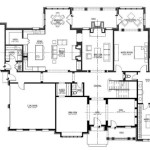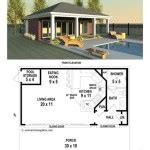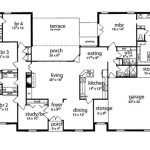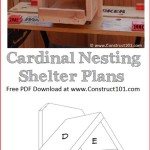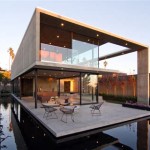In the realm of residential architecture, the concept of open floor plans has gained immense popularity, particularly in the design of small houses. Open floor plans in small houses refer to a layout where interior walls are minimized or eliminated, creating a sense of spaciousness and cohesion. By removing traditional room dividers, these plans aim to maximize natural light, foster a sense of community, and promote flexibility in space utilization.
A prime example of an open floor plan small house is the Tiny House Movement. These compact dwellings prioritize space-saving strategies and often incorporate open floor plans to create a sense of livability in a limited footprint. The open plan allows for multiple functions to be accommodated within a single room, such as cooking, dining, sleeping, and storage.
As we delve deeper into the topic of open floor plans in small houses, we will explore the advantages and disadvantages of this design approach, discuss space-saving techniques, and provide tips for incorporating these plans into your own small home project.
Open floor plans in small houses offer a range of benefits, including increased space perception, improved natural light distribution, and enhanced flexibility in space usage.
- Maximize space
- Enhance natural light
- Increase flexibility
- Foster community
- Improve accessibility
- Reduce construction costs
- Promote energy efficiency
- Create a sense of flow
- Facilitate multi-functionality
However, it’s important to consider potential drawbacks such as reduced privacy, noise transmission, and the need for careful space planning.
Maximize space
Open floor plans are particularly effective in maximizing space in small houses. By eliminating or minimizing interior walls, these plans create a more spacious and airy feel, even in compact dwellings. The absence of walls allows for a more efficient use of space, as furniture and other belongings can be arranged in a way that maximizes both functionality and flow.
One of the key space-saving strategies in open floor plans is the use of multi-functional furniture. For example, a sofa can double as a bed, a coffee table can incorporate storage drawers, and a dining table can extend to accommodate additional guests. By choosing furniture that serves multiple purposes, homeowners can reduce clutter and make the most of the available space.
Open floor plans also lend themselves to the use of vertical space. High shelves, lofts, and built-in storage solutions can be incorporated to maximize vertical storage capacity without sacrificing floor space. Additionally, the use of natural light can be optimized in open floor plans, as the absence of walls allows light to penetrate deeper into the home, reducing the need for artificial lighting and creating a more spacious feel.
Overall, the adoption of open floor plans in small houses offers a range of space-saving benefits, making them an ideal choice for homeowners seeking to create a sense of spaciousness and livability in a compact footprint.
Enhance natural light
Open floor plans play a significant role in enhancing natural light in small houses. By eliminating or minimizing interior walls, these plans allow for ample daylight to penetrate deeper into the home, creating a brighter and more inviting living space.
One of the key advantages of open floor plans is the ability to maximize window placement. With fewer walls to obstruct the flow of light, homeowners can strategically position windows to capture natural light from multiple angles. Large windows, skylights, and sliding glass doors can be incorporated to flood the interior with sunlight, reducing the need for artificial lighting during the day.
In addition to maximizing window placement, open floor plans promote the distribution of natural light throughout the home. Without the of walls, light can easily travel from one area to another, creating a more evenly lit space. This is particularly beneficial in small houses, where natural light can be limited due to the compact size.
Furthermore, the use of reflective surfaces in open floor plans can further enhance natural light. Light-colored walls, ceilings, and flooring reflect and bounce light around the room, amplifying its intensity and creating a more spacious feel. Additionally, the use of mirrors can strategically reflect light into darker areas, improving the overall illumination of the home.
Overall, open floor plans offer a range of benefits for enhancing natural light in small houses. By maximizing window placement, promoting light distribution, and incorporating reflective surfaces, these plans create brighter, more inviting, and visually appealing living spaces.
Increase flexibility
Open floor plans in small houses offer a significant advantage in terms of flexibility, allowing homeowners to adapt their living spaces to changing needs and preferences.
- Adaptability to changing needs
As life circumstances change, the ability to reconfigure the layout of a home becomes increasingly valuable. Open floor plans provide this flexibility, as the absence of walls allows for easy rearrangement of furniture and the creation of new spaces to accommodate different uses.
- Multi-functionality
Open floor plans lend themselves to multi-functional spaces that can serve a variety of purposes. For example, a living area can double as a dining room or a guest room, while a kitchen can incorporate a breakfast nook or a home office. This flexibility allows homeowners to maximize the utility of their space and create a home that adapts to their evolving needs.
- Accommodating different lifestyles
Open floor plans can be tailored to suit different lifestyles and preferences. Whether you prefer open and social living spaces or more defined and private areas, an open floor plan can be customized to create a living environment that aligns with your unique needs.
- Future-proofing
The flexibility of open floor plans allows homeowners to future-proof their homes against changing circumstances. As families grow or downsize, or as individual needs evolve, the ability to reconfigure the layout of the home without major renovations can be invaluable.
In summary, open floor plans in small houses offer exceptional flexibility, enabling homeowners to adapt their living spaces to changing needs, accommodate different lifestyles, and future-proof their homes against unforeseen circumstances.
Foster community
Open floor plans in small houses not only enhance space and flexibility, but also play a crucial role in fostering a sense of community and togetherness among family members and guests.
- Encouraging interaction
The open and connected nature of open floor plans promotes interaction and communication between occupants. Without physical barriers like walls, family members can easily engage in activities together, share meals, and participate in shared experiences.
- Building relationships
The shared spaces created by open floor plans provide ample opportunities for family members to connect and build stronger relationships. Whether it’s children playing together, parents helping with homework, or friends gathering for dinner, the open layout encourages social interaction and fosters a sense of belonging.
- Creating a sense of belonging
Open floor plans contribute to a sense of belonging by visually connecting different areas of the home. This allows family members to feel part of a cohesive unit, even when they are engaged in different activities. The absence of walls helps to break down traditional boundaries and promotes a feeling of togetherness.
- Promoting inclusivity
Open floor plans can be particularly beneficial for families with members of different ages or abilities. By eliminating barriers and creating a level playing field, open floor plans promote inclusivity and ensure that everyone feels welcome and valued.
Overall, open floor plans in small houses play a vital role in fostering community by encouraging interaction, building relationships, creating a sense of belonging, and promoting inclusivity. These plans provide a welcoming and cohesive living environment where family members and guests can connect, share experiences, and create lasting memories.
Improve accessibility
Open floor plans in small houses offer significant advantages in terms of accessibility, particularly for individuals with mobility impairments, elderly residents, and families with young children.
Elimination of barriers
By removing interior walls and creating a continuous open space, open floor plans eliminate physical barriers that can hinder movement and access. This is particularly beneficial for individuals who rely on wheelchairs, walkers, or other mobility aids, as they can navigate the home with greater ease and independence.
Enhanced maneuverability
The open and uncluttered nature of open floor plans provides ample space for maneuvering, reducing the risk of falls and accidents. Wide doorways and hallways allow for smooth movement, while the absence of sharp corners and narrow passages minimizes the risk of collisions or obstructions.
Adaptability to assistive devices
Open floor plans can be easily adapted to accommodate assistive devices such as wheelchair ramps, stairlifts, and grab bars. The flexibility of the open layout allows for these devices to be seamlessly integrated into the home environment, ensuring that individuals with disabilities can move around safely and comfortably.
Universal design principles
Open floor plans align with universal design principles, which aim to create accessible and inclusive environments for people of all abilities. By incorporating features such as lever handles, adjustable countertops, and accessible showers, open floor plans can be tailored to meet the specific needs of individuals with disabilities, allowing them to live independently and with dignity.
Overall, open floor plans in small houses provide numerous accessibility benefits, creating a safe, comfortable, and inclusive living environment for individuals with diverse needs.
Reduce construction costs
Open floor plans in small houses offer potential cost savings during the construction phase. Here are several ways in which open floor plans can help reduce construction costs:
Fewer interior walls
The most significant cost saving in open floor plans stems from the reduced need for interior walls. Walls require framing, drywall, insulation, and finishing materials, which can add up to a substantial expense. By eliminating or minimizing interior walls, open floor plans significantly reduce these costs.
Simplified framing
Open floor plans simplify the framing process, as there are fewer walls to frame and support. This reduces the amount of lumber and labor required, leading to further cost savings.
Reduced need for doors and windows
With fewer walls, there is a reduced need for doors and windows. This can result in significant savings on materials and installation costs. Additionally, open floor plans often incorporate large windows and sliding glass doors to maximize natural light, which can be more cost-effective than installing multiple smaller windows.
Efficient use of space
Open floor plans promote efficient use of space, as there are no wasted hallways or unused corners. This allows for a smaller overall footprint, which can lead to savings on building materials and labor costs.
Overall, the reduced need for materials, simplified framing, and efficient use of space in open floor plans can translate into substantial cost savings during the construction phase of a small house.
Promote energy efficiency
Open floor plans in small houses offer several advantages in terms of energy efficiency, contributing to lower energy consumption and reduced utility bills.
Maximized natural light
Open floor plans allow for ample natural light to penetrate deeper into the home, reducing the need for artificial lighting during the day. This can lead to significant energy savings, especially in areas with abundant sunlight. Large windows, skylights, and sliding glass doors can be strategically placed to capture natural light and illuminate the interior, minimizing the reliance on electricity.
Improved air circulation
The absence of interior walls in open floor plans promotes better air circulation throughout the home. This allows for natural ventilation, reducing the need for air conditioning or heating systems to maintain a comfortable temperature. Cross-ventilation can be achieved by strategically positioning windows and doors to create airflow paths, which helps regulate the indoor temperature and reduces energy consumption.
Efficient heating and cooling
Open floor plans facilitate the efficient distribution of heat and cool air throughout the home. Without interior walls to airflow, heating and cooling systems can operate more effectively, ensuring that all areas of the house are evenly heated or cooled. This reduces energy waste and creates a more comfortable living environment.
Reduced energy loss
Open floor plans minimize the amount of exterior wall surface area compared to traditional compartmentalized layouts. This reduces the potential for heat loss or gain through exterior walls, as there are fewer surfaces exposed to the outside environment. Additionally, open floor plans allow for better insulation, as there are fewer walls to insulate, resulting in improved energy efficiency and lower heating and cooling costs.
Overall, open floor plans in small houses promote energy efficiency through maximized natural light, improved air circulation, efficient heating and cooling, and reduced energy loss. These factors contribute to a more sustainable and cost-effective living environment.
Create a sense of flow
In the realm of interior design, the concept of “flow” refers to the smooth and effortless transition between different spaces within a home. Open floor plans in small houses play a crucial role in creating a sense of flow, as they eliminate traditional barriers and allow for a more cohesive and interconnected living environment.
One of the key advantages of open floor plans is the ability to create a visual connection between different areas of the home. By removing walls, the interior space becomes more open and inviting, allowing natural light to penetrate deeper into the home and creating a sense of spaciousness. This visual connection encourages movement and interaction between different zones, promoting a more dynamic and engaging living experience.
Furthermore, open floor plans facilitate a seamless flow of movement throughout the home. The absence of walls and creates clear and unobstructed pathways, allowing occupants to move freely between different spaces without encountering physical barriers. This fluidity of movement enhances the overall functionality of the home, making it easier to perform everyday tasks and navigate through the space, particularly in small houses where every square foot counts.
Additionally, open floor plans promote a sense of visual continuity, as the eye can easily travel from one area to another without being obstructed by walls. This creates a cohesive and unified living environment, where different spaces complement each other and contribute to the overall aesthetic of the home. The absence of visual barriers allows for a more harmonious and balanced interior design, enhancing the overall ambiance and creating a more inviting and comfortable living space.
In summary, open floor plans in small houses create a sense of flow by fostering visual connections, facilitating seamless movement, and promoting visual continuity. These factors combine to create a more dynamic, functional, and aesthetically pleasing living environment that enhances the overall experience of living in a small home.
Facilitate multi-functionality
Open floor plans in small houses excel at facilitating multi-functionality, allowing homeowners to maximize space utilization and create versatile living environments that adapt to their evolving needs. By eliminating or minimizing interior walls, open floor plans provide a flexible canvas upon which multiple functions can be accommodated within a single room.
One of the most common examples of multi-functionality in open floor plans is the combination of living, dining, and kitchen areas into a single, cohesive space. This layout, often referred to as the “great room” concept, creates a spacious and inviting central hub for daily life. The open and interconnected nature of the space allows for seamless transitions between different activities, whether it’s cooking, dining, entertaining guests, or simply relaxing.
Another example of multi-functionality in open floor plans is the incorporation of home offices or study areas within the living space. By strategically placing a desk or workspace within the open layout, homeowners can create a dedicated area for work or study without sacrificing valuable space. This integration of work and living areas allows for a more flexible and efficient use of space, particularly for those who work from home or need a dedicated space for their hobbies or creative pursuits.
Additionally, open floor plans lend themselves to the creation of multi-purpose rooms that can transform to accommodate different functions as needed. For example, a guest room can double as a home office or a playroom for children, while a loft area can serve as a cozy reading nook or an additional sleeping space. The flexibility of open floor plans allows homeowners to adapt their spaces to suit their changing needs and preferences, ensuring that their homes remain functional and comfortable over time.
In summary, open floor plans in small houses facilitate multi-functionality by providing flexible and adaptable spaces that can accommodate multiple functions within a single room. This allows homeowners to maximize space utilization, create versatile living environments, and adapt their homes to their evolving needs and preferences.










Related Posts



